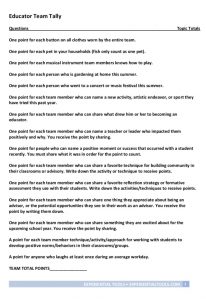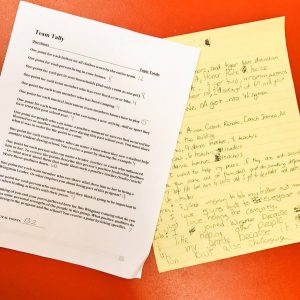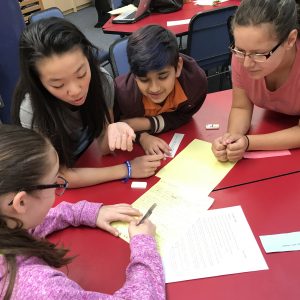Oct 05, 2017 Team Tally for Group Building, Reflection, Academic Review, and Data Gathering
 This group questionnaire has multiple purposes: rapport building, reflection, data gathering, brainstorming, context setting, and academic or training content review/assessment. The playful, informal, small-group sharing and friendly competition engage and motivate participants to join in. Because it is so participant- directed it is ideal for transitional phases (i.e., the first few moments of a program, meal-time, or when returning from a break. It can be used to explore get-to-know-you questions or as a reflective technique to gather specific information and feedback about a topic, or to celebrate an experience. It is a useful technique for large groups (groups are broken down into smaller teams).
This group questionnaire has multiple purposes: rapport building, reflection, data gathering, brainstorming, context setting, and academic or training content review/assessment. The playful, informal, small-group sharing and friendly competition engage and motivate participants to join in. Because it is so participant- directed it is ideal for transitional phases (i.e., the first few moments of a program, meal-time, or when returning from a break. It can be used to explore get-to-know-you questions or as a reflective technique to gather specific information and feedback about a topic, or to celebrate an experience. It is a useful technique for large groups (groups are broken down into smaller teams). In school settings, it is perfect for advisory groups or family nights. In adult training and team-building, I use it to ensure all voices are heard when exploring a particular subject. I always have it with me as a backup option if something comes up where I need to engage the group in an activity while I have to deal with an administrative issue. It is useful when part of the group is late, and I want to get those in the room engaged in a meaningful activity while we wait for others to arrive.
 Materials: Choose/create a Team Tally that fits your group. Below are a few examples. I tailor them to each group. On my desktop, I have a folder with over 50 team tally with various questions that suit the specific group’s personality and goals (email me at jen@experientialtools.com if you would like one of these templates in word).
Materials: Choose/create a Team Tally that fits your group. Below are a few examples. I tailor them to each group. On my desktop, I have a folder with over 50 team tally with various questions that suit the specific group’s personality and goals (email me at jen@experientialtools.com if you would like one of these templates in word).
Facilitation Suggestions:
• Divide participants into small teams of 4 to 6 participants.
• Ask team mates to talk through the list and come up with a cumulative score for each item.
• This usually leads to engaging conversation and connections as group members listen to and learn from each other and their thought’s and opinions about a subject. For information gathering, training, and reflection versions, ask participants to write their answers on an additional sheet so both you and the group can refer back to the information gathered later.
• After the groups finish, ask them to share about their tally. I de-emphasize the score and focus on process/content by asking them to share about the specific questions that elicited the most interesting responses.
 Outcomes/Reflections: Youth and adult groups enjoy this activity. The combination of sharing, competition, and collaboration draws in learners. I find that through the conversations people make connections with peers outside their usual social circle. In a high school classroom, I had two students who usually did not get along well connect over a discussion about whether they should count the members of two households in the tally. Both students were struggling with recent divorces in their families and shuttling between two houses. This activity initiated a discussion and bond over similar circumstances that continued throughout the school year. Adjust the questions to fit your group’s personalities and goals. In my peer leadership and facilitation training programs, I design the questions in a way to get participants thinking of the ideal qualities of a leader or educator so we can come back to their own words later in training (see example below). In other workshops, I ask specific questions about favorite facilitation techniques which initiates sharing and learning about the content at hand from each other. Again, I include their brainstormed lists in workshop follow up resources they can use later.
Outcomes/Reflections: Youth and adult groups enjoy this activity. The combination of sharing, competition, and collaboration draws in learners. I find that through the conversations people make connections with peers outside their usual social circle. In a high school classroom, I had two students who usually did not get along well connect over a discussion about whether they should count the members of two households in the tally. Both students were struggling with recent divorces in their families and shuttling between two houses. This activity initiated a discussion and bond over similar circumstances that continued throughout the school year. Adjust the questions to fit your group’s personalities and goals. In my peer leadership and facilitation training programs, I design the questions in a way to get participants thinking of the ideal qualities of a leader or educator so we can come back to their own words later in training (see example below). In other workshops, I ask specific questions about favorite facilitation techniques which initiates sharing and learning about the content at hand from each other. Again, I include their brainstormed lists in workshop follow up resources they can use later. Samantha Parker, a high school science teacher from Lincoln-Sudbury Regional High School, created a Science Team Tally to use in her physics class. Her goals were to build community among lab groups, introduce physics concepts, create context, and promote inquiry. You can see other specific examples on page 137-139 of my Inspired Educator, Inspired Learner book or Tips & Tools for the Art of Experiential Group Facilitation.
Reference/Resources: This activity was inspired by my colleague Karl Rohnke. At a workshop many years ago we used a variation he called “Yay Teachers” (Funn’ n Games) and I adapted it to this longer version with reflective questions.



No Comments